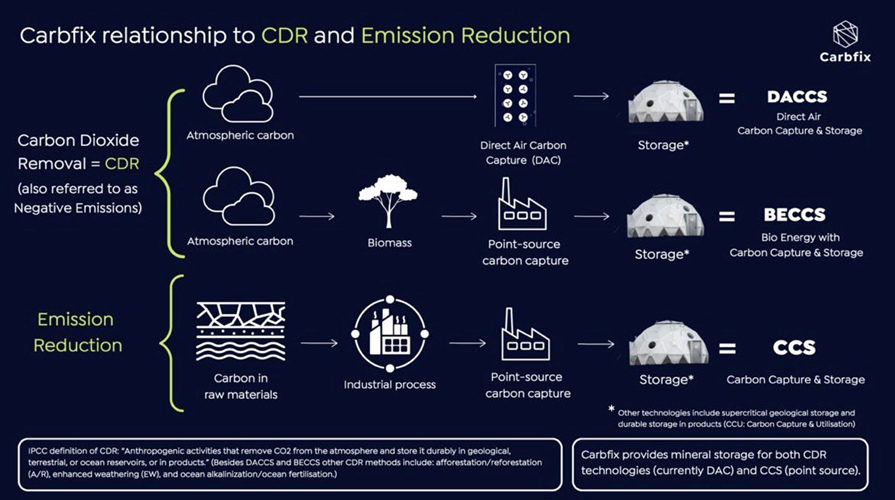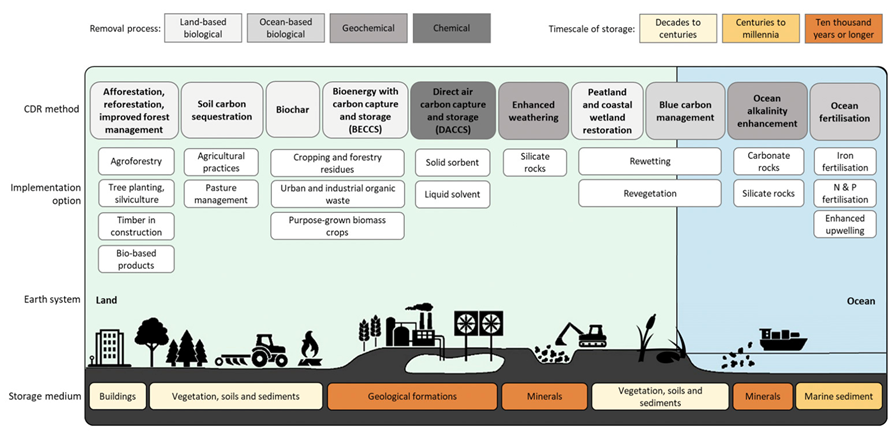Carbon dioxide removal (CDR) is the process of capturing carbon dioxide (CO₂) from the atmosphere and permanently storing it in plants, soils, oceans, geological features, or long-lived products like cement, where it can be locked away for decades or centuries – this results in a negative emission. Negative emissions can be achieved through a wide-array of approaches, both technological and nature-based.
Technological removal approaches include:
- Direct Air Capture and Storage (DACS) is the removal of CO₂ directly from the atmosphere, using scrubbers and chemical processes, and storage underground or in products.
- Bioenergy with Carbon Capture and Storage (BECCS) is the process of using biomass to generate energy for industrial, power or transportation purposes, capturing the emissions before they are released in the atmosphere and permanently storing the captured carbon underground or in long-lived products. This technology can provide net carbon removal if it leads to more biomass growth than it would normally occur, or if more carbon is stored than being released back into the atmosphere. Biomass with Carbon Removal and Storage (BiCRS) is a related approach, which involves the permanent storage of any carbon emissions from biogenic emissions (including biogas plants, biomass plants, waste combustion plants and wastewater treatment plants).
Most prominent nature-based removal practices are:
- Soil carbon sequestration (also known as carbon farming or regenerative agriculture): the sum of land management practices that enable soils to absorb and hold more carbon.
- Afforestation/ reforestation: storing CO₂ in newly grown or re-grown forests.
- Enhanced mineralisation (also known as enhanced weathering or accelerated weathering): accelerating the natural process through which certain minerals capture CO₂ from the atmosphere.
- Ocean-based CDR: amplification of the ocean’s capacity to absorb and store CO₂ from the atmosphere.
CDR is different from point-source carbon capture from the fossil power sector and heavy industry, with the key distinction being that CDR is targeting CO₂ that is already in the atmosphere (including via biomass), while conventional CCS captures the carbon from fossil fuel combustion at the point-source, before it has entered the atmosphere.
Most credible pathways compatible with the 1.5 degrees temperature goal of the Paris Agreement require the use of carbon dioxide removal (CDR). While CDR cannot replace emission reductions, it fulfils three crucial roles:
- reducing CO₂ emissions levels in the short-term;
- counterbalancing residual emissions from hard-to-abate sectors in order to reach net zero CO₂ in the medium-term; and
- achieving net negative CO₂ emissions in the long-term.
CDR capacities will need to grow significantly. CDR is an integral part of a net-zero transition – the IPCC estimates that 1.9–16.1 GtCO₂ of removals will be required annually by 2050 to reach net zero. Negative emission technologies, notably biomass energy with carbon capture and storage (BECCS) and direct air capture and storage (DACS), will therefore be required at scale to achieve net-zero- and 1.5-degree goals. However, their current adoption rates remain very low.
Both nature-based and technological removals play an important part in cities’ net-zero strategies. Nature-based solutions adapted to cities, such as increasing public green spaces, community gardens and green roofs also have the benefit of reducing air pollution and improving wellbeing. However, due to the limited available land in cities or in their immediate proximity, cities would also have to rely on engineered removals to achieve their targets. The use of technology-based CDR solutions in cities net-zero strategies would not only support the achievement of their own target, by providing measurable, durable removals, but would also send a strong signal of support for these technologies. Public funding is a critical element in scaling up these innovative technologies, seen as essential for meeting our climate goals.


Comments ()